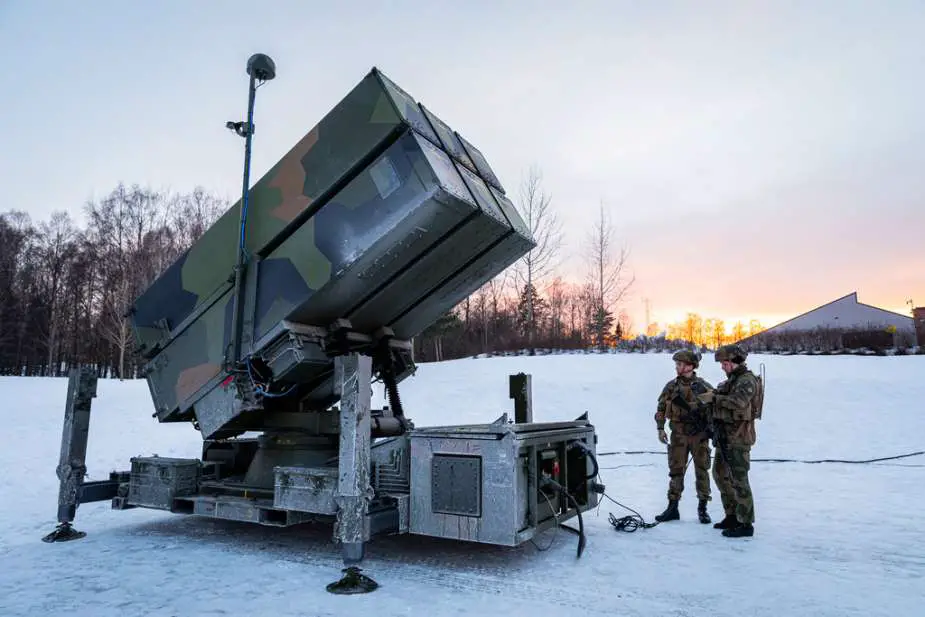Breaking news
Norway Raytheon and Kongsberg join forces to improve NASAMS air defense capabilities.
On October 31, 2023, the Norwegian Ministry of Defence announced an agreement to enhance the National Advanced Surface-to-Air Missile System (NASAMS) air defense capabilities. This partnership was formalized in Washington, D.C., and includes Norway, the American company Raytheon, and the Norwegian company Kongsberg Defence & Aerospace.
Follow Army Recognition on Google News at this link

A Norwegian NASAMS air defense system deployed as part of exercise Joint Viking near Oslo in 2023. (Picture source: Norway MoD)
Bjørn Arild Gram, Norway's Minister of Defence, stressed the importance of strengthening air defense to protect civilian and military targets from airborne threats, citing recent events, such as the conflict in Ukraine. Kjetil Reiten Myhra, Executive Vice President of Integrated Defence Systems at Kongsberg Defence & Aerospace, expressed anticipation for continued collaboration to improve NASAMS, focusing on enhancing its mobility and operational flexibility for future protection of people and critical assets. This could potentially indicate the development of a truck-mounted version, similar to the IRIS-T SLM from the German company Diehl Defense mounted on an 8x8 truck chassis.
Tom Laliberty, President of Land & Air Defence Systems at Raytheon, noted the global significance of this initiative and highlighted the ongoing investment in the evolution of NASAMS to support the Norwegian Armed Forces and global allies. This reflects the increasing demand for NASAMS air defense systems seen in 2023. Several NASAMS air defense systems were sent to Ukraine this year, provided by Norway, the United States, and Lithuania. In July 2023, Taiwan also announced its purchase of NASAMS through the United States.
The cooperative arrangement with Kongsberg and Raytheon is seen as a foundation for further developing the NASAMS air defense system against future threats to continue safeguarding civilian and military assets amid new security challenges, although specific details have not been released.
The decision to develop new NASAMS capabilities came after Lars Lervik, chief of staff of the Norwegian Army, announced that Norway had chosen to forgo the acquisition of 18 German-made Leopard 2A8 main battle tanks. Instead, the country decided to bolster its air defense and long-range fire capabilities, as reported on October 11, 2023.
To support future NASAMS procurement, the Norwegian government plans to seek parliamentary approval for two key air defense projects in the upcoming 2023 state budget revisions under the Ministry of Defence. These projects are known as Project 7821 and Project 1146. Project 7821 aims to acquire tailored missiles for NASAMS air defense systems to reinforce its operational capabilities, while Project 1146 focuses on re-acquiring main components to ensure the sustainability and effectiveness of the NASAMS system. A proposal to modify the scope of Project 7628, Combat Air Defense, is also under consideration due to previous donations.
The NASAMS, or the National Advanced Surface-to-Air Missile System, has been in service since 1997. It was developed collaboratively by Norway and the United States and manufactured by Kongsberg Defence & Aerospace in conjunction with Raytheon Missiles & Defense.
In contrast to systems that require a large team to operate, the NASAMS is designed for efficiency, requiring only a two-person crew. This minimizes labor costs and facilitates its deployment in various operational scenarios.
In terms of performance, the NASAMS is versatile, with different versions offering varying capabilities. The NASAMS 2, equipped with the AMRAAM missile, has an effective firing range of 30 km. The more advanced NASAMS 3, using the AMRAAM-ER missile, extends this range to 50 km. The system's radar capabilities are noteworthy. The NASAMS 2, equipped with the MPQ-64F1 radar, has a radar track range of 120 km, allowing ample time for decision-making and engagement of incoming threats.
The NASAMS 2 can engage targets at altitudes up to 21 km, while the NASAMS 3 variant, with the AMRAAM-ER missile, can reach altitudes as high as 35.7 km. This high-altitude capability is significant for defending against various aerial threats, from low-flying drones to high-altitude bombers.


























